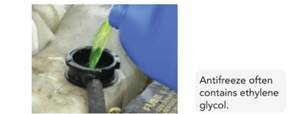
Concept explainers
Ethylene glycol,
a. What are the empirical formulas of ethylene glycol and oxalic acid?
b. If ethylene glycol has a C¬C single bond with two H atoms attached to each C atom, what is its Lewis structure?
c. Which bonds in ethylene glycol are polar covalent and which are nonpolar covalent?
d. How many milliliters of ethylene glycol could be toxic for an 11.0-lb cat?
e. What would be the strongest intermolecular force in ethylene glycol?
f. If oxalic acid has two carbon atoms attached by a C¬C single bond with each carbon also attached to two oxygen atoms, what is its Lewis structure?
g. Write the balanced chemical equation for the reaction of ethylene glycol and oxygen

Want to see the full answer?
Check out a sample textbook solution
Chapter 10 Solutions
Basic Chemistry
- A newspaper article states that biomass has actually been used as an energy source throughout human history. Do you agree or disagree with this statement? Defend your answer.arrow_forward4.61 What is actually measured by the octane ratings of different grades of gasoline?arrow_forwardThe carbon dioxide exhaled in the breath of astronauts is often removed from the spacecraft by reaction with lithium hydroxide 2LiOH(s)+CO2(g)Li2CO3(s)+H2O(l) Estimate the grams of lithium hydroxide required per astronaut per day. Assume that each astronaut requires 2.50 103 kcal of energy per day. Further assume that this energy can be equated to the heat of combustion of a quantity of glucose, C6H12O6, to CO2(g) and H2O(l). From the amount of glucose required to give 2.50 103 kcal of heat, calculate the amount of CO2 produced and hence the amount of LiOH required. The H for glucose(s) is 1273 kJ/mol.arrow_forward
- How many carbon monoxide molecules (CO) are needed to react with 8 hydrogen molecules (H2) to produce methyl alcohol molecules (CH3OH)?arrow_forward(a) Butane gas, C4H10, can burn completely in air [use O2(g) as the other reactant] to give carbon dioxide gas and water vapor. Write a balanced equation for this combustion reaction. (b) Write a balanced chemical equation for the complete combustion of C3H7BO3, a gasoline additive. The products of combustion are CO2(g), H2O(g), and B2O3(s).arrow_forwardAcetone, (CH3)2CO, is an important industrial compound. Although its toxicity is relatively low, workers using it must be careful to avoid flames and sparks because this compound burns readily in air. Write the balanced equation for the combustion of acetone.arrow_forward
- 4.1 List at least two factors that make it difficult to describe the combustion of gasoline accurately. What assumption can be made to address these complications?arrow_forwardMany over-the-counter antacid tablets are now formulated using calcium carbonate as the active ingredient, which enables such tablets to also be used as dietary calcium supplements. As an antacid for gastric hyperacidity, calcium carbonate reacts by combining with hydrochloric acid found in the stomach, producing a solution of calcium chloride, converting the stomach acid to water, and releasing carbon dioxide gas (which the person suffering from stomach problems may feel as a “burp”). Write the unbalanced chemical equation for this process.arrow_forward4.6 Use the web to research prices of gasoline at the pump for consumers in your area during the past year. Also find information about the price of crude oil for the same period. Discuss any correlations you observe between the two prices.arrow_forward
- You are given mixtures containing the following compounds. Which compound in each pair could be separated by stirring the solid mixture with water? (a) NaOH and Ca(OH)2 (b) MgC12 and MgF2 (c) AgI and KI (d) NH4Cl and PbCl2arrow_forwardMany cereals are made with high moisture content so that the cereal can be formed into various shapes before it is dried. A cereal product containing 58% H2O by mass is produced at the rate of 1000. kg/h. What mass of water must be evaporated per hour if the final product contains only 20.% water?arrow_forward3.82 The particulate scale drawing shown depicts the products of a reaction between N2 and O2 molecules. (a) Draw a similar representation for the reactants that must have been present before the reaction took place. (b) Write a balanced chemical equation for the reaction, using the smallest possible whole number coefficients.arrow_forward
 Chemistry & Chemical ReactivityChemistryISBN:9781337399074Author:John C. Kotz, Paul M. Treichel, John Townsend, David TreichelPublisher:Cengage Learning
Chemistry & Chemical ReactivityChemistryISBN:9781337399074Author:John C. Kotz, Paul M. Treichel, John Townsend, David TreichelPublisher:Cengage Learning Chemistry: The Molecular ScienceChemistryISBN:9781285199047Author:John W. Moore, Conrad L. StanitskiPublisher:Cengage Learning
Chemistry: The Molecular ScienceChemistryISBN:9781285199047Author:John W. Moore, Conrad L. StanitskiPublisher:Cengage Learning Chemistry: An Atoms First ApproachChemistryISBN:9781305079243Author:Steven S. Zumdahl, Susan A. ZumdahlPublisher:Cengage Learning
Chemistry: An Atoms First ApproachChemistryISBN:9781305079243Author:Steven S. Zumdahl, Susan A. ZumdahlPublisher:Cengage Learning
 ChemistryChemistryISBN:9781305957404Author:Steven S. Zumdahl, Susan A. Zumdahl, Donald J. DeCostePublisher:Cengage Learning
ChemistryChemistryISBN:9781305957404Author:Steven S. Zumdahl, Susan A. Zumdahl, Donald J. DeCostePublisher:Cengage Learning Chemistry & Chemical ReactivityChemistryISBN:9781133949640Author:John C. Kotz, Paul M. Treichel, John Townsend, David TreichelPublisher:Cengage Learning
Chemistry & Chemical ReactivityChemistryISBN:9781133949640Author:John C. Kotz, Paul M. Treichel, John Townsend, David TreichelPublisher:Cengage Learning





